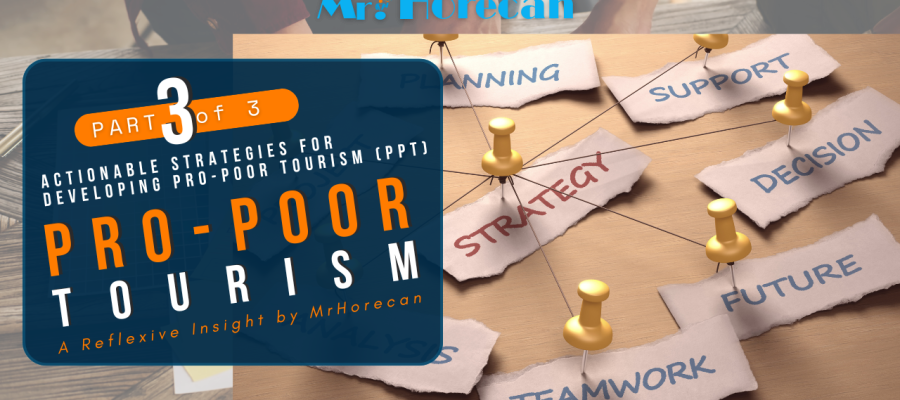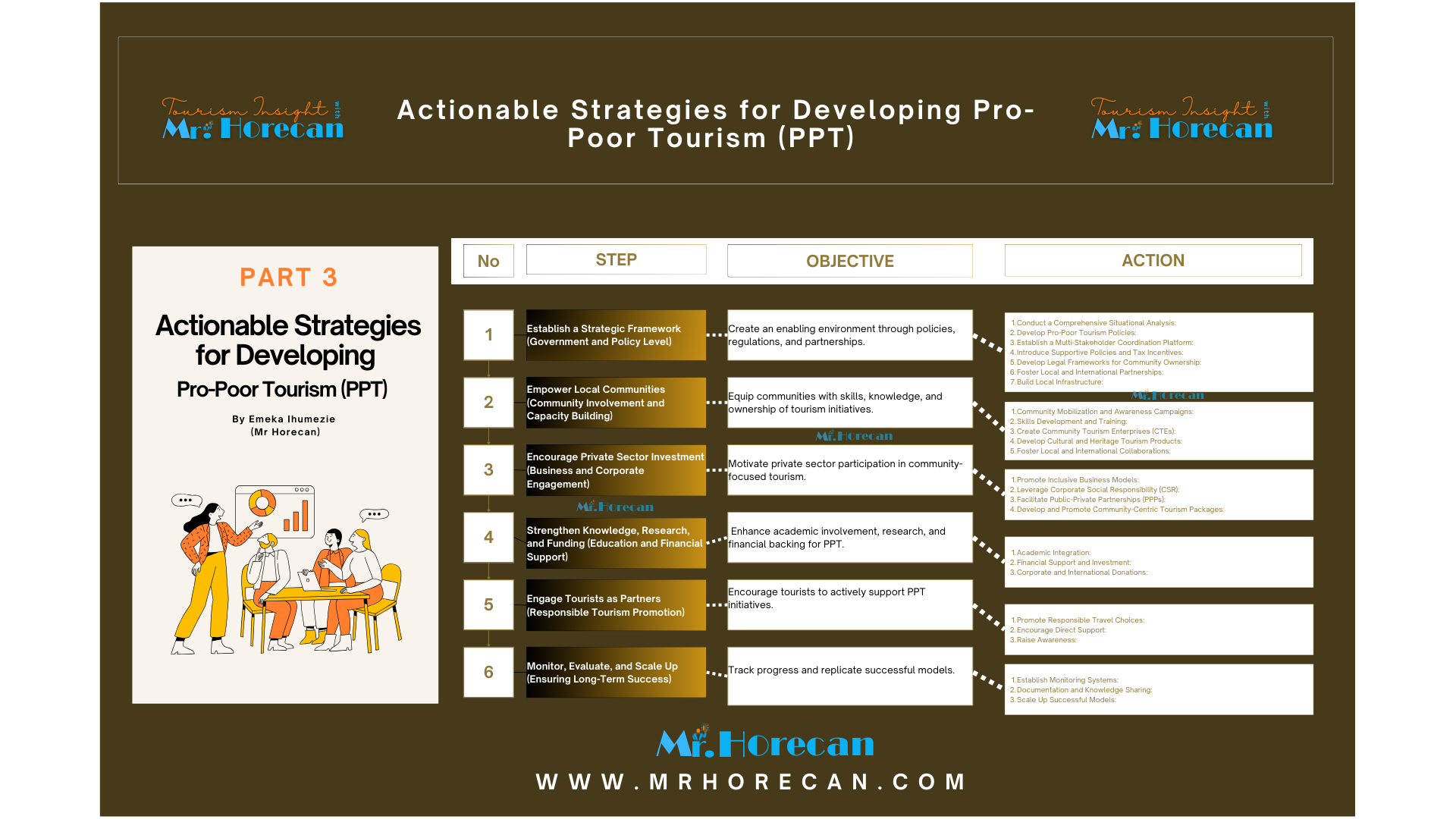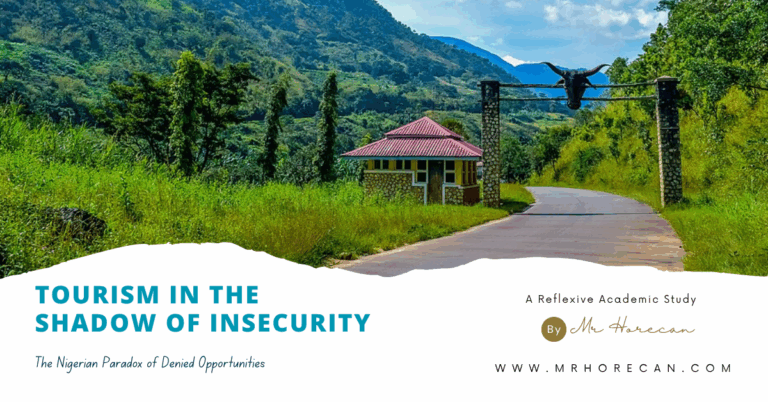
INTRODUCTION
Welcome to the third part of our exploration of Pro-Poor Tourism (PPT). In the first part, we laid the foundation by understanding what PPT is, its origins, and the rationale behind this inclusive approach to tourism. We examined how traditional tourism models often bypass marginalized communities, leaving them economically sidelined, while PPT seeks to ensure that tourism revenue directly benefits those who need it most. In the second part, we explored the opportunities, challenges, and impacts of PPT, discussing how successful initiatives have positively transformed communities while also highlighting the practical barriers to its implementation.
Now, in this final part, we will shift our focus to actionable strategies for stakeholders looking to develop and sustain Pro-Poor Tourism. Implementing PPT requires a structured, collaborative approach involving governments, private businesses, local communities, NGOs, educational institutions, financial bodies, international organizations, and tourists. This section will provide practical steps to create inclusive tourism models that benefit marginalized communities while fostering sustainable development.

Step 1:
Establish a Strategic Framework (Government and Policy Level)
To develop Pro-Poor Tourism effectively, it is crucial to start with a solid strategic framework. Governments must take the lead by creating policies, regulations, and partnerships that enable community involvement in tourism projects.
The first step is to conduct a comprehensive situational analysis. Governments need to identify tourism potential areas that coincide with high poverty rates. This involves assessing existing infrastructure, cultural assets, and the readiness of communities to engage in tourism. Engaging local stakeholders is vital to understand their expectations, aspirations, and potential challenges.
Next, it is essential to develop policies that mandate community participation in tourism initiatives. Governments should integrate PPT objectives into national tourism strategies, promoting sustainable practices that align with environmental and social goals. This should be complemented by creating multi-stakeholder coordination platforms that include government bodies, local leaders, private businesses, NGOs, educational institutions, and financial entities. These platforms facilitate ongoing collaboration and knowledge sharing.
Supportive policies and tax incentives can significantly boost PPT. Governments should offer tax breaks to companies that invest in community tourism projects, particularly those that focus on sustainable and locally beneficial practices. Introducing duty-free import options for essential tourism equipment can also encourage investment. Furthermore, establishing legal frameworks to protect community land rights is essential to prevent displacement and ensure that local populations benefit directly from tourism developments.
Fostering partnerships is another crucial aspect. Governments should collaborate with international organizations like the UNWTO and bilateral partners to gain technical support and funding for PPT projects. Building local infrastructure—such as roads, clean water facilities, and digital connectivity—is fundamental to making tourism destinations accessible and appealing to visitors. Public-private partnerships (PPPs) can be particularly effective in mobilizing resources for infrastructure projects.
Step 2:
Empower Local Communities (Community Involvement and Capacity Building)
Empowering local communities is at the heart of Pro-Poor Tourism. This process begins with raising awareness about the economic and social benefits of tourism through community mobilization initiatives. Workshops, community meetings, and local media can play a vital role in building enthusiasm and understanding among community members.
Skill development is crucial to ensure communities can take on meaningful roles within the tourism sector. Governments and NGOs should partner with educational institutions to provide training in tourism management, customer service, guiding, and hospitality. Tailored programs focusing on eco-tourism, cultural heritage management, and leadership will build a skilled workforce capable of managing community tourism assets.
Establishing community tourism enterprises (CTEs) can foster local ownership and entrepreneurship. Community cooperatives can manage lodges, cultural centers, craft shops, and guided tour services, ensuring that revenue stays within the community. Cultural and heritage tourism products, such as storytelling sessions, traditional dance performances, and craft-making workshops, offer unique experiences that attract responsible travelers while preserving cultural integrity.
Fostering collaborations with international tourism networks and neighboring communities will broaden market reach and encourage cultural exchange. Local governments should actively support these initiatives, recognizing that community involvement enhances the authenticity and sustainability of tourism experiences.
Step 3:
Encourage Private Sector Investment (Business and Corporate Engagement)
The private sector plays a pivotal role in developing sustainable tourism models that benefit local communities. Governments should encourage businesses to adopt inclusive practices, promoting joint ventures with local communities. This approach not only shares profits but also transfers skills and knowledge.
Corporate social responsibility (CSR) initiatives can be instrumental in supporting community tourism projects. Companies should be encouraged to allocate a portion of their profits to build community infrastructure or provide training programs. Offering tax incentives for CSR investments can further motivate businesses to support PPT.
Public-private partnerships (PPPs) offer another avenue for development. For example, tourism infrastructure projects can be co-funded by private investors in exchange for operational rights, with a portion of revenues directed to community initiatives. Additionally, developing tourism packages that include community-based experiences can make local offerings more visible and appealing to responsible travelers.
"Pro-Poor Tourism works best when communities lead, governments support, businesses invest, and travelers care.
Step 4:
Strengthen Knowledge, Research, and Funding (Education and Financial Support)
Integrating Pro-Poor Tourism concepts into academic curricula can promote a deeper understanding of sustainable tourism. Universities should include PPT modules in tourism, hospitality, and business courses. Research on the socioeconomic impacts of PPT initiatives can provide valuable insights and help refine strategies.
Financial support is vital for community tourism enterprises. Governments and financial institutions should offer microfinance options and low-interest loans to enable local entrepreneurs to start tourism ventures. International financial institutions can also provide grants to support infrastructure improvements. Creating community tourism funds from tourism levies can ensure ongoing financial support.
Step 5:
Engage Tourists as Partners (Responsible Tourism Promotion)
Educating tourists about the importance of supporting local communities is key to successful PPT. Travelers should be encouraged to choose community-run accommodations and tours, directly contributing to local economies. Special packages that combine cultural immersion with eco-friendly practices can attract ethically-minded visitors.
In addition, creating opportunities for direct support—such as donation portals for community projects or volunteer programs—can enhance the social impact of tourism. Promoting responsible storytelling through travel blogs and social media can raise awareness about the positive effects of PPT.
Step 6:
Monitor, Evaluate, and Scale Up (Ensuring Long-Term Success)
Effective monitoring and evaluation are essential to track the progress of PPT initiatives. Governments and community leaders should establish metrics to assess the social, economic, and environmental impacts of tourism projects. Regular feedback from community members can guide improvements and address emerging challenges.
Successful PPT models should be documented and shared as case studies, offering guidance for other regions seeking to develop similar initiatives. International recognition of successful projects can attract further investment and enhance the credibility of community-led tourism efforts.
Conclusion: Fostering Sustainable Development Through Pro-Poor Tourism
Pro-Poor Tourism has the potential to transform marginalized communities by fostering economic inclusion, cultural preservation, and sustainable development. By following these structured, strategic steps, stakeholders can create resilient tourism models that genuinely benefit local populations. Governments, private businesses, communities, NGOs, and tourists all have a role to play in building tourism ecosystems that are not only profitable but also socially equitable and environmentally sound.
Key Takeaways
- Pro-Poor Tourism thrives on collaboration—governments, communities, the private sector, NGOs, and tourists must work together to build inclusive tourism ecosystems.
- Strategic policy frameworks are essential; governments must lead with supportive regulations, infrastructure development, and legal protections for community ownership.
- Empowering local communities through education, skills training, and ownership of tourism enterprises is central to PPT’s success.
- Private sector engagement should go beyond profit—businesses are encouraged to invest in community-led tourism through joint ventures and corporate social responsibility (CSR) programs.
- Sustainable funding mechanisms such as microfinance, tourism levies, and international grants are crucial to support community tourism initiatives.
- Tourists are active partners in PPT—through conscious choices, direct support, and ethical storytelling, they play a key role in sustaining community-based tourism.
- Continuous monitoring and evaluation ensure accountability, allow for adaptation, and help scale successful models across regions.



